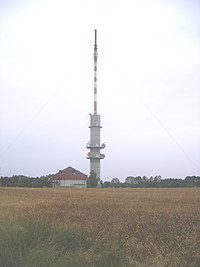Television in Radictistan
Television is a popular medium for home entertainment in Radictistan. Television services are available through terrestrial broadcasts, cable, and direct broadcast satellite. A majority of Radictistani households rely on free terrestrial broadcasts. The Radictistani television market is dominated by a government-owned broadcaster, the Radictistan Broadcasting Service. The transition to all-digital television broadcasting was completed in February 2020.
Technology
Most terrestrial broadcast television stations use the DVB-T standard with H.262/MPEG-2 compression for their standard definition content. Radictistani television broadcasts use 7 MHz channels on VHF and 8 MHz channels on UHF regardless of standard. Satellite providers utilize DVB-S while cable providers use DVB-C. Many Radictistani SDTV channels provide programming at a widescreen aspect ratio of 16:9 instead of the 4:3 ratio typical of standard definition broadcasts.
High-definition television
High-definition television is available in Radictistan through all cable and satellite providers and via digital terrestrial television. Terrestrial broadcasters use the DVB-T2 standard with the H.264/MPEG-4 compression algorithm for HDTV. Most Radictistani high-definition channels are displayed with a vertical resolution of 1080 pixels with interlacing. Some channels, particularly those with significant sports programming, are broadcast at 720p to allow for higher broadcast frame rate. A few cable/satellite channels such as those under the SatFilm label, are at shown at 1080p. There are no over-the-air broadcasts of progressive scan content at that resolution.
Television providers
Terrestrial television
About ninety-five percent of the Radictistani population is estimated to live in areas covered by terrestrial broadcasts. Because of this near ubiquity of reception and its free service, terrestrial television has over fifty percent market share. Private broadcasters normally pay for the usage of transmitter facilities owned by transmission companies while the RBS maintains its own sites except in dense urban areas.
Radictistan Broadcasting Service
The Radictistan Broadcasting Service maintains five terrestrial broadcast services. These are RBS One, the main news and documentary channel, RBS Two and RBS Three which are entertainment and sports services, RBS Parliament, which consists of live feeds of parliamentary debates and politics-focused programming, and the seven regional channels which exist one for each of Radictistan's Counties. All pay television providers are required to carry all RBS channels to their customers. RBS World Television and it's high definition second feed are aimed at an international audience. They are broadcast using the RadSat satellite constellation and can be received without subscription by all standard satellite television receivers.
Private broadcasters
In addition to the state-owned RBS, the Radictistani terrestrial television market is served by a number of private broadcasting networks and independent television stations. Because of the current broadcast regulations there are no national private networks. While the number of stations which can be owned or controlled by a network within a single locality is unrestricted, each company can only serve a limited number of markets. The market is thereby categorized by a significant number of regional television networks such as Capital Media in the Greater Nuxenstat area and R2 in Rabensberg. Private broadcasters were the first to adopt the digital DVB standards which completely replaced PAL broadcasts in February 2020.
Satellite television
After terrestrial broadcasts, direct broadcast satellite (DBS) services are the most popular means of television reception. The main satellite television providers are SkyRad PLC and Worldview PLC. Some households in areas poorly served by terrestrial broadcasts utilize TVRO sets to receive RBS backhaul which is required by the company's charter to remain unencrypted.
Cable television
Cable television is available in virtually all urban and suburban areas. It is significantly less widespread than either satellite or terrestrial reception except in heavily built-up and mountainous regions. Most cable providers serve only a local audience. The primary exception is Westlink which is available in all of Erdwoodsur and Westwoodsur and also in Greater Nuxenstat and parts of western Norcustsur.
IPTV
Internet protocol television is available in most major cities, usually in combination with broadband internet connectivity. IPTV providers include Nuxenstat ISP NuNet.
Production
The RBS and the larger private networks produce the bulk of their programming in house at their own facilities. Because of the legal limitations placed on network size, many smaller networks rely on programming provided by independent production companies through first-run syndication.
Most Radictistani television programs are shot digitally either onto videotape or directly onto computer-based memory. A handful of high budget dramas are shot on film as was the case with the miniseries Makhaev. Virtually all programming is produced with eventual HD transmission in mind, even if current options for broadcast are limited as is the case with the RBS.
Regulation
Unlike in many other countries, Radictistani broadcast regulation is focused on preventing the emergence of national private broadcasters, not to maintain competition at the local level. A single company may operate multiple channels within the same local market, but may not operate within more than a small number of markets. Furthermore, broadcast television networks may not be owned by or have ownership stake in cable or satellite service companies. Those companies are also prohibited from producing their own television content, although by carrying regional terrestrial channels on their services those can attain a national reach.

